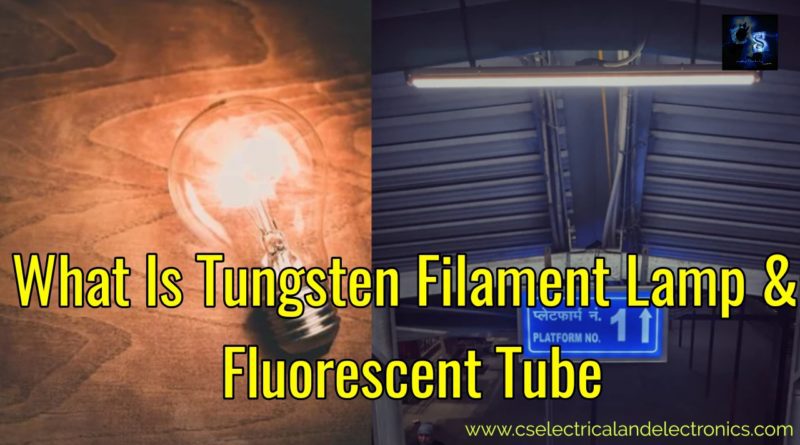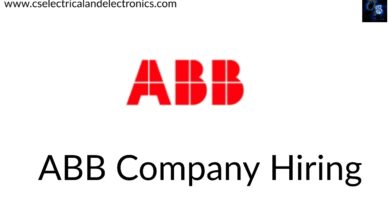What Is Tungsten Filament Lamps And Fluorescent Tubes
Hello Guys, welcome back to my blog. In this article, I will discuss what is tungsten filament lamps and fluorescent tubes, the difference between them, I will also discuss about difference between tungsten filament and fluorescent tubes.
If you want an article on some other topics then comment us below in the comment box. You can also catch me @ Instagram – Chetan Shidling.
Also read – Electrical Estimation And Costing Questions And Answers.
Tungsten Filament Lamps And Fluorescent Tubes
What is Tungsten Filament Lamps?
Filament Lamp – When an electric current is passed through a fine metallic wire, heat is produced and the temperature of the wire increases. At low temperature, the wire radiates heat energy, as the temperature of the wire increases due to heating it radiates heat as well as light energy.
The higher the temperature of the wire, the higher is the amount of light energy radiated. A black body when heated at 6250 degrees C emits the maximum energy in the visible spectrum range.
The incandescent or filament type lamp consists of a glass globe as shown in the above figure completely evacuated and a wire, called a filament, within it. The glass globe is evacuated to prevent the oxidation and convection currents of the filament and also to prevent the temperature being lowered by radiation.

The material, which can be used for the filaments of incandescent lamps, must possess the properties of high melting point, high resistivity, low-temperature coefficient, ductility, low vapor pressure, etc.
The material used in filament lamps is normally tungsten, carbon, tantalum, and osmium.
Carbon filament has a melting point of 3,500 degrees C, but it has many drawbacks i.e., resistance will decrease as temperature increases and it will draw more current from mains
Osmium is also a filament but it is very rarely used and the cost of this metal is very expensive. The melting point of the osmium melt is 2,600 degrees C.
Tantalum – It has a melting point of 2,800 degrees C only and it can not be operated at a higher temperature to give good efficiency.
Tungsten – Tungsten is also a filament, nowadays in every filament lamps, tungsten melt is used because it has many advantages like high melting point, high resistivity, mechanically strong, etc.
What are Fluorescent Tubers?
Fluorescent Tubes has many advantages compared to filament lamps. The fluorescent tube will also emit light when supply is given to it. The tubes can be obtained at a different size.
Fluorescent Tubes with wattage and length.
- 01. 38 cm long tube has 14 watts.
- 02. 46 cm long tube has 15 watts.
- 03. A 61 cm length tube has 20 watts.
- 04. 100 cm long tube has 25 watts.
- 05. 122 cm long tube has 40 watts.
- 06. 152 cm long tube has 65 watts.
- 07. 152 cm long tube has 80 watts.

The fluorescent tube consists of a glass tube of the same diameter and length of the tubes as given above. The inside surface of glass i.e., a tube is coated by silicate, cadmium, etc. Those elements used for coating are called phosphors. The tube also contains a small quantity of argon gas at a pressure of 2.5 mm of mercury. The fluorescent tube also consists of two electrodes coated with electron emissive material.
A starting switch is provided in the circuit, which puts the electrode directly across the supply mains at the time of starting, so that electrodes may get heated and emit sufficient electrons. A stabilizing choke is connected in series with it, which acts as ballast in running condition and provides a voltage impulse for starting. A capacitor is connected across the circuit to improve the power factor.
Difference Between Tungsten Filament Lamps And Fluorescent Tubes
01. Voltage fluctuation has comparatively more effect on the light output in the case of filament lamps whereas in the case of fluorescent tubes voltage fluctuation has a comparatively low effect because in tube choke is present.
02. In the case of filament, luminous efficiency increases with the increase in voltage of the lamp whereas in the case of fluorescent tubes luminous efficiency increases with the increase in wattage and an increase in the length of tubes.
03. In the case of filament, it gives light close to natural light, therefore, objects are properly seen whereas in the case of fluorescent tubes it does not give light close to natural light, therefore, color rendering is defective.
04. In the case of filament, the luminous efficiency of colored filament lamps is poor because colored glasses are used for this purpose whereas, in the case of fluorescent tubes, different color lights can be obtained by using the different components of the fluorescent powder. Hence efficiency is high and better colors are obtained.
05. In the case of filament, due to comparatively high working temperature heat radiations are also present whereas in the case of tubes, due to low working temperature heat radiations are low.
06. In the case of filament, the brightness of the light is more whereas in tube brightness of the light is less.
07. In both cases, time light output will reduce.
08. The life of filament lamps varies with the working voltage, normally it has a life span of 1,000 working hours. The life span of the tube is 7,500 working hours.
09. The initial cost of both lights is low.
I hope this article may help you all a lot…..
Thank You For Reading…… Bye
Tags: What Is Tungsten Filament Lamps And Fluorescent Tubes, Difference Between Them, what is a filament, what is tungsten, what is osmium, what is carbon filament, the difference between filament and fluorescent tubes.
Also, read:
- 10 Tips To Maintain Battery For Long Life, Battery Maintainance
- 10 Tips To Save Electricity Bills, Save Money By Saving Electricity
- 100 (AI) Artificial Intelligence Applications In The Automotive Industry
- 100 + Electrical Engineering Projects For Students, Engineers
- 1000+ Control System Quiz, Top MCQ On Control System
- 1000+ Electrical Machines Quiz, Top MCQs On Electrical Machines
- 1000+ MATLAB Simulink Projects For MTech, Engineering Students
- 50 Tips To Save Electricity At Home, Shop, Industry, Office
- 50+ Question And Answer On The Substation, Electrical Question
- 500+ Matlab Simulink Projects Ideas For Engineers, MTech, Diploma
- 500+ Projects For Diploma Electrical, Electronics Student, Diploma Project
- Active Cell Balancing Using A Flyback Converter Simulation In Matlab Simulink
- AI Artificial Intelligence Applications In Electric Vehicles | Future?
- AI Tools For Electronic Circuit Design, Which Is Best?
- Applications Of Artificial Intelligence (AI) In Renewable Energy
- Automotive Industry Or VLSI Chip Industry ? Which Is Best?
- Basic Electrical Engineering, Terms, Definitions, SI Unit, Formula
- Basic Electrical Quiz, Take Online Test On Basic Electrical, Electrical Quiz
- Battery C Rate Online Calculator With Time Calculation
- Battery Management Systems In Electric Vehicles, BMS Operations
Author Profile
- Chetu
- Interest's ~ Engineering | Entrepreneurship | Politics | History | Travelling | Content Writing | Technology | Cooking
Latest entries
 All PostsApril 19, 2024What Is Vector CANoe Tool, Why It Is Used In The Automotive Industry
All PostsApril 19, 2024What Is Vector CANoe Tool, Why It Is Used In The Automotive Industry All PostsApril 13, 2024What Is TCM, Transmission Control Module, Working, Purpose,
All PostsApril 13, 2024What Is TCM, Transmission Control Module, Working, Purpose, All PostsApril 12, 2024Top 100 HiL hardware in loop Interview Questions With Answers For Engineers
All PostsApril 12, 2024Top 100 HiL hardware in loop Interview Questions With Answers For Engineers All PostsMarch 22, 2024Driver Monitoring Systems In Vehicles, Working, Driver Sleepy Alert
All PostsMarch 22, 2024Driver Monitoring Systems In Vehicles, Working, Driver Sleepy Alert








